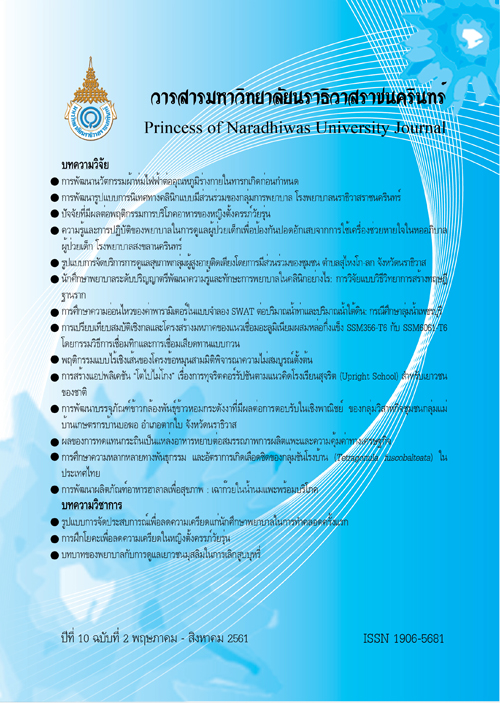ผลการใช้เศษเหลือทิ้งจากปาล์มน้ำามันในสูตรอาหารผสมสำาเร็จในแพะต่อการใช้ประโยชน์ได้ ของโภชนะปริมาณกรดไขมันที่ระเหยง่าย และเมแทบอไลซ์ในเลือด
คำสำคัญ:
ปาล์มน้ำามัน, อาหารผสมสำาเร็จ, กรดไขมันที่ระเหยง่าย, เมแทบอไลซ์ในเลือด, แพะบทคัดย่อ
การวิจัยครั้งนี้มีวัตถุประสงค์เพื่อ ศึกษาผลของการใช้เศษเหลือทิ้งจากปาล์มนำ้ามันในสูตรอาหารผสมสำาเร็จต่อการใช้
ประโยชน์ได้ของโภชนะ ปริมาณกรดไขมันที่ระเหยง่าย และเมแทบอไลซ์ในเลือดของแพะ โดยใช้แพะลูกผสมพื้นเมือง-แองโกล
นูเบียน 50% เพศผู้ อายุ 1.1±0.02 ปี นำ้าหนักตัวเฉลี่ย 25±3 กิโลกรัม จำานวน 5 ตัว ใช้แผนการทดลองแบบ 5 x 5 ลาตินสแควร์
โดยแบ่งแพะทดลองออกเป็น 5 กลุ่มให้แพะได้รับอาหารผสมสำาเร็จเศษเหลือทิ้งจากปาล์มน้ำามัน คือกลุ่มที่ 1 อาหารผสมสำาเร็จ
ฟางข้าว 30% กลุ่มที่ 2 อาหารผสมสำาเร็จทางใบปาล์มน้ำามันหมัก 30% กากปาล์มน้ำามัน 20% กากตะกอนปาล์มน้ำามัน 30%
กลุ่มที่ 3 อาหารผสมสำาเร็จทางใบปาล์มน้ำามันหมัก 30% กากปาล์มน้ำามัน 40% กลุ่มที่ 4 อาหารผสมสำาเร็จทางใบปาล์มน้ำามัน
หมัก 30% กากปาล์มน้ำามัน 20% กากตะกอนปาล์มน้ำามัน 20% และกลุ่มที่ 5 อาหารผสมสำาเร็จทางใบปาล์มน้ำามันหมัก 30%
กากปาล์มน้ำามัน 25% กากตะกอนปาล์มน้ำามัน 25%
ผลการทดลองพบว่า ปริมาณวัตถุแห้งและโปรตีนที่แพะได้รับในกลุ่มที่ได้รับอาหารสูตรที่ 2 และ 4 มีค่าสูงกว่าแพะที่ได้รับอาหารสูตรที่ 1, 3 และ 5 แตกต่างกันอย่างมีนัยสำาคัญทางสถิติ (P<0.05) สัมประสิทธิ์การย่อยได้ของวัตถุแห้ง พบว่าแพะที่ได้รับอาหารสูตรที่ 2, 4 และ 5 มีค่าสัมประสิทธ์ิการย่อยได้ของวัตถุแห้งสูงกว่าแพะที่ได้รับอาหารสูตรที่ 1 และ 3 แตกต่างอย่างมีนัยสำาคัญทางสถิติ (P<0.05) นอกจากนี้สัมประสิทธิ์การย่อยได้ของโปรตีน พบว่าแพะที่ได้รับอาหารสูตรที่ 2 และ 4 มีค่าสัมประสิทธิ์การย่อยได้ของโปรตีนสูงกว่าแพะที่ได้รับอาหารสูตรที่ 1, 3 และ 5 แตกต่างกันอย่างมีนัยสำาคัญทางสถิติ (P<0.05)สมดุลของไนโตรเจน ในแพะกลุ่มที่ 2 มีค่าสูงสุดแตกต่างอย่างมีนัยสำาคัญทางสถิติ (P<0.05) ส่วนปริมาณกรดไขมันระเหยง่ายพบว่า ค่าเฉลี่ยของกรดอะซิติคในแพะที่ได้รับอาหารสูตรที่ 1, 2, 4 และ 5 มีค่าสูงกว่าสูตรที่ 3 แตกต่างอย่างมีนัยสำาคัญทางสถิติ (P<0.05) ค่าเฉลี่ยของกรดโพรพิโอนิกในแพะที่ได้รับอาหารสูตรที่ 3 และ 5 มีค่าสูงกว่าสูตรที่ 1, 2 และ 4 แตกต่างอย่างมีนัยสำาคัญทางสถิติ (P<0.05) และค่าเฉลี่ยของกรดบิวทีริคในแพะที่ได้รับอาหารสูตรที่ 1 และ 5 มีค่าสูงกว่าสูตรที่ 2, 3 และ4 แตกต่างอย่างมีนัยสำาคัญทางสถิติ (P<0.05) อย่างไรก็ตาม ค่าความเป็นกรดด่าง แอมโมเนียไนโตรเจน ของแพะทุกกลุ่มอยู่ในช่วงปกติ นอกจากนั้น ค่าปริมาตรเม็ดเลือดแดงอัดแน่น กลูโคส และยูเรียไนโตรเจนในเลือดของแพะทุกกลุ่มมีค่าไม่แตกต่างกันทางสถิติ ดังนั้นจึงสามารถใช้อาหารผสมสำาเร็จเศษเหลือทิ้งจากปาล์มน้ำามันเป็นอาหารแพะได้ โดยไม่ส่งผลกระทบต่อการกินได้ การย่อยได้ กรดไขมันที่ระเหยง่าย และเมแทบอไลซ์ในเลือดแพะ
เอกสารอ้างอิง
Bremner, J. M. & Keeney, D.R. (1965). Stream distillation methods of determination of ammonium, nitrate and nitrite. Analytica Chimica Acta, 32, 363.
Cheva-Isarakul, B. (1999). Biochemical in Animal. Department of Animal Science Faculty of Agriculture, Chiang Mai University. (in Thai)
Dijkstra, J. (1994). Production and absorption of volatile fatty acids in the rumen. Livestock Production Science, 39, 61.
Eksomtramet, T., Ninlanon, C., Jantaraniyom, T., & Tongkam, P., & Seesanong, S. (2005). Successful of Oil Palm Production. Oil Palm Research and Development Center Faculty of Natural Resources Prince of Songkla University. (in Thai)
Goering, H. K. &Van Soest, P. J. (1970). Forage Fiber Analysis (Apparatus, Reagents, Procedures and some Applications). Agricultural Handbook No. 379, USDA.
Higginbothum, G.E., Torabi, M. & Huber, J.T. (1989). Influence of dietary protein concentration and degradability on performance of lactating cows during hot environmental temperatures. Journal of Dairy Science, 72, 2554-2564.
Ishida, M. & Abu Hassan, O. (1997). Utilization of oil palm front as cattle feed. Japan Agricultural Research Quarterly, 13, 41-47.
Jain, N. C. (1993). Essential of Veterinary Hematology. Philadelphia : Lea & Febiger.
Kaneko, J.J. (1980). Clinical Biochemistry of Domestic Animal. (4th ed.). San Diego, California: Academic Press Inc.
Lazzaro, J. (2005). Normal blood chemistry values for adult goats. Available Source: http://www.saanendoah.com/bloodvalues.html, December 9, 2011.
Lloyd, S. (1982). Blood characteristics and the nutrition of ruminants. British Veterinary Journal, 138, 70-85.
Nousiainen, J., Shingfield, K.J. & Huntanen, P. (2004). Evaluation of milk urea nitrogen as diagnostic of protein feeding. Journal of Dairy Science, 87, 386-394.
NRC. (1981). Nutrient Requirements of Goat: Angora, dairy and meat goats in temperate and Tropical countries.
Nutrient Requirements of Domestic Animals. No 15.Washington, DC. National Academes of Science.
Perdok, H. K. & Leng, R. A. (1990). Effect of supplementation with protein meal on the growth of cattle given a basal diet of untreated or ammoniated rice straw. Asian-Australasian Journal of Animal Sciences, 3, 269-279.
Pimpa, B., Ruangsuwan, S., & Pimpa, O. (2009). The characteristic and Chemical composition of By-Products
from oil palm as feed from factory. Seminar Agriculture 10th. Khon Kaen University 13 Feb 2009. 221-223. (in Thai)
Pralomkarn, W. (1999). Goat meat and milk in humid tropics. School of Agricultural Technology Walailak University, Nakhon Si Thammarat.
Rattanagoson, N., Ngampongsai, W., Wattanchant, C., & Kuprasert, S. (2009). Effect of oil palm frond silage mixed with different levels of molasses on intake and nutrient utilization in goat. Khon Kaen Agriculture Journal, 37, 235-244.
Soulinthone, S. and Khejornsart, P. (2016). Effect of roughage source in total mixed ratio silage on Feed intake nutrient digestibilities and rumen of ecology in Sheep. Khon Kaen Agriculture Journal, 44(2), 83-91.
Saenphoom, P. (2003). Effect of Protein in Concentrate and rice straw or fermented rice straw with urea on goat and sheep performance, carcass and acceptable of human. Master degree Department of Animal Science Faculty of Agriculture Khon Kaen University. (in Thai)
Samuel, M., Sagathewan, S., Thomas, J. & Mathen, G. (1997). An HPLC method for estimation of volatile fatty acid of ruminal fluid. Indian journal of animal science, 67, 805-807.
Steel, R.G. & Torrie, J. H. (1980). Principles and Procedures of Statistics: A Biometrical Approach. (2nd ed.). New York: McGraw-Hill.
Tadsri, S. (2004). Tropical Forages. Department of Agronomy, Facutry of Agriculture, Kasetsart University, Bangkok.
Teimouri, Y .A. R., Valizadeh, A., Christensen, D. & Eftekhari, S.F. (2004). Effect of alfalfa particle size and specific gravity on chewing activity digestibility and performance of Holstein dairy cows. Journal of Dairy Science, 87, 3912-3924.
Wachirapakorn, C. (1998). Feed and Feeding ruminant. Department of Animal Science Faculty of Agriculture Khon Kaen University. (in Thai)
Wanapat, M. (1990). Ruminant Nutrition. Department of Animal Science Faculty of Agriculture Khon Kaen University. (in Thai)
Wattanasit S., & Kuprasert, S. (2001). The utilization of Palm Kernel Cake in feed. Songklanakarin Journal of Science and Technology, 23, 741-752.




